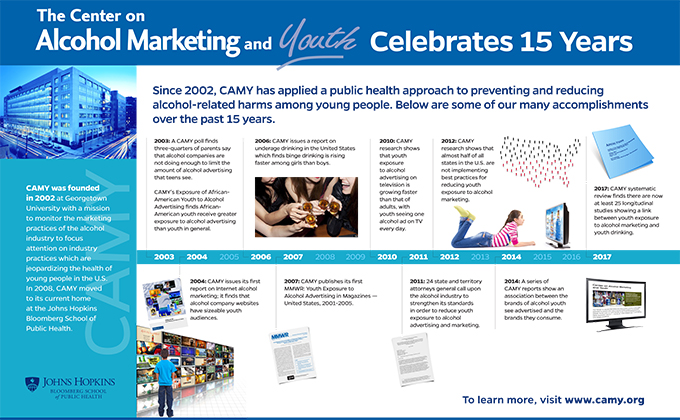Center on Alcohol Marketing and Youth Turns 15
Click timeline to enlarge.
Preventing and Reducing Alcohol-Related Problems Among Young People Since 2002
A vacation in a bottle … romance in a glass … the winning team … . Alcohol ads permeate media and culture with the promise of fun, love and victory.
As director and co-founder of the Bloomberg School’s Center on Alcohol Marketing and Youth (CAMY), which is marking its fifteenth anniversary, David Jernigan focuses on how alcohol marketing can reach and appeal to young people.
In his East Baltimore office, bottles and bottles of booze wrapped in brightly colored labels line the shelves. He uses these flavored vodkas and candy-striped malt beverages as visual examples in his lectures around the world on alcohol industry marketing and its relationship to underage drinking.
 “There’s a well-documented association between kids’ exposure to alcohol marketing and kids’ drinking behavior, and we can do something about it,” says Jernigan (left), who leads CAMY’s research and advocacy work aimed at protecting youth from unsafe alcohol use. CAMY dedicates the bulk of its work to "monitoring the marketing to look at where it’s ending up and who it’s [actually] reaching” to help inform the industry and other key audiences.
“There’s a well-documented association between kids’ exposure to alcohol marketing and kids’ drinking behavior, and we can do something about it,” says Jernigan (left), who leads CAMY’s research and advocacy work aimed at protecting youth from unsafe alcohol use. CAMY dedicates the bulk of its work to "monitoring the marketing to look at where it’s ending up and who it’s [actually] reaching” to help inform the industry and other key audiences.
Alcohol is the number one drug used by children in the U.S., causing approximately 4,350 deaths among youths under 21 every year. Youth alcohol consumption is also associated with risky sexual behavior, sexual assault, academic failure, physical injuries and alcohol poisoning.
In 2002, when CAMY was a nascent research group at Georgetown University, federal efforts to reduce underage drinking focused primarily on enforcement of the legal drinking age. CAMY’s mission from the start was to take a broader approach, and bring attention and action on alcohol industry practices that jeopardize the health and safety of America's youth. Fifteen years later, it remains the only organization in the U.S. dedicated to monitoring marketing practices of the alcohol industry. CAMY's work now also encompasses research and public health practice across the three “best buys” for alcohol problems prevention according to the World Health Organization: physical availability, alcohol pricing, and alcohol marketing.
CAMY’s research studies alcohol marketing from different angles including visual representation or content, pricing, and availability, as determined by zoning laws and density of outlets, for example.
CAMY also examines the relationships between kids’ exposure to alcohol marketing—how, where, and how often—and their drinking behaviors. According to Jernigan, numerous studies have found not only a strong relationship between exposure and drinking but—more troubling—between exposure and the evolution from experimentation with alcohol to what he terms “heavy or hazardous” drinking.
Unlike tobacco marketing, the alcohol industry is almost entirely self-regulated. Since 2016, CAMY, in collaboration with Craig Ross, PhD, MBA, and other researchers from Boston University, has prepared quarterly reports documenting where and when on television alcohol companies do not comply with their own advertising code regarding exposure to youth audiences. The researchers rely on data from Nielsen, the television measurement systems company, to determine how often an alcohol ad appears during programming seen disproportionately by young viewers. These reports are publicly available as an awareness tool and to let the the alcohol industry know that these figures are being tracked.
Consistently, the findings show that youths under 21 are seeing billions of alcohol advertising impressions on cable TV, and that about one in ten of these impressions do not comply with the alcohol industry's self-regulated code. However, since the reporting began, analysis of raw Nielsen indicates that violations may have dropped by as much as 60 percent. More research is needed to fully flesh out the connection to CAMY’s reporting, but, Jernigan finds the numbers “promising” as an indication that change is afoot.
While underage drinking has dropped overall in the last 15 years, Jernigan is particularly concerned about two developing challenges.
First, there has been a smaller decline in drinking among girls, a trend that Jernigan attributes in part to the rise of alcopops like Smirnoff Ice and Bacardi Silver which appeal to women as fun, flavorful alternatives to beer.
Other transgressors on the market, he says, are the brightly colored, candy-flavored vodkas and high-proof fruit-flavored malt beverages. The crux of the issue: underage girls are imbibing drinks with some of the highest alcohol content available.
The second new(er) challenge for CAMY is that advertising has changed significantly since 2002, with an increase both in screen time for young adults and in the different types of screens they’re viewing. Social media has powerful amplification potential for marketing, making alcohol ads much more ubiquitous and harder to track.
The bottom line is that underage drinking has not been reduced as much as it can be, and youth are seeing far too many ads for alcohol on many platforms including television and social media. Still, CAMY—and Jernigan—remain undeterred.
“We continue to try to influence and reduce the messaging from alcohol marketers that, to my mind, undercuts all the hard work my colleagues are doing in communities to try to reduce youth access,” says Jernigan. He envisions a world where if alcohol is consumed, it's not consumed heavily or in high-risk populations including underage youth. He is convinced that those are achievable goals.
“[People tell me] alcohol is so cultural, people use it everywhere, we couldn’t possibly change the culture, [but], thirty years ago people said the same thing about tobacco,” Jernigan observes. “Advertising is changing and reinforcing cultural change all the time; public health’s job is to push back on that.”
CAMY provides a multitude of reports and tools including an alcohol tax increase impact calculator, galleries, infographics and reports.
- RELATED - Raimee Eck, MPA, MPH's “Binge Drinking and Associated Health Risks Among Underage Youth” presentation at last year's APHA conference in Denver.

